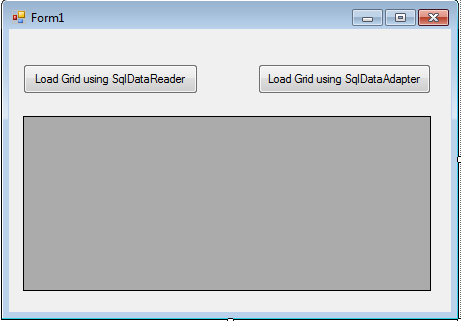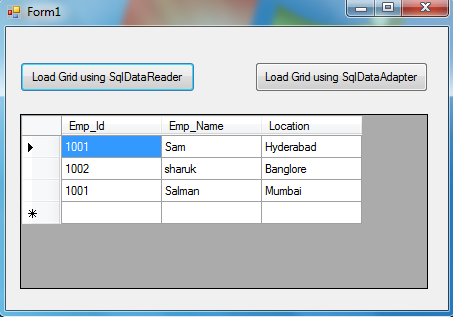Working with DataGridView in C#.Net and VB.Net windows forms application
# Bind Data to Datagridview in C#.Net, VB.NET Windows Application
# Display/Fill/Populate Data in DataGridView in C#.Net, VB.NET Windows Application
# Bind data to DataGridView in Windows Forms in C#.Net and VB.Net
# Display/Fill/Populate Data in DataGridView in C#.Net, VB.NET Windows Application
# Bind data to DataGridView in Windows Forms in C#.Net and VB.Net
In this article i am going to explain about Binding Data to a DataGridView in C#.Net and VB.Net windows application . we can do this in two ways using SqlDataReader and SqlDataAdapter . Here we will see a small example of using SqlDataReader and SqlDataAdapter to bind data to DataGridView.For this i am designing a form as follows.

The C# code in the code behind file is like this.
using System;
using System.Data;
using System.Windows.Forms;
using System.Data.SqlClient;
namespace DataGridView1
{
public partial class Form1 : Form
{
public Form1()
{
InitializeComponent();
}
SqlCommand cmd;
SqlDataReader reader;
SqlConnection con = newSqlConnection(“data source=localhost;initial catalog=mydb;Integrated security=true”);
// SqlConnection con = new SqlConnection(“Data Source=<Server Name>;user id=<user name of sql server>;
password=<password of sql server>;Initial Catalog=<Database Name>”;
private voidForm1_Load(object sender, EventArgs e)
{
dataGridView1.AllowUserToAddRows = false;
dataGridView1.AllowUserToDeleteRows = false;
dataGridView1.ReadOnly = true;
}
/// <summary>
/// //function to bind data to datagridview using SqlDataReader
/// </summary>
public voidBindGridUsingDataReader()
{
//for data table we have to include namespace System.Data
DataTable table = newDataTable();
cmd = new SqlCommand(“SELECT * FROM EMPDetails”, con);
con.Open();
reader = cmd.ExecuteReader();
table.Load(reader);
dataGridView1.DataSource = table;
reader.Close();
// table.Clear();
con.Close();
dataGridView1.ReadOnly = true;
}
/// <summary>
/// //function to bind data to datagridview using SqlDataAdapter
/// </summary>
public voidBindDataGridUsingDataAdapter()
{
DataSet ds = new DataSet();
cmd = new SqlCommand(“SELECT * FROM EMPDetails”, con);
SqlDataAdapter da = newSqlDataAdapter(cmd);
da.Fill(ds); //filling DataSet
dataGridView1.DataSource = ds.Tables[0];
}
/// <summary>
/// button click
/// </summary>
/// <param name=”sender”></param>
/// <param name=”e”></param>
private voidbtn_LoadGridDr_Click(object sender, EventArgs e)
{
try
{
BindGridUsingDataReader();
}
catch (Exceptionex)
{
MessageBox.Show(ex.Message);
}
}
/// <summary>
/// button click code
/// </summary>
/// <param name=”sender”></param>
/// <param name=”e”></param>
private voidbtn_LoadGridDa_Click(object sender, EventArgs e)
{
try
{
BindDataGridUsingDataAdapter();
}
catch (Exceptionex)
{
MessageBox.Show(ex.Message);
}
}
}
}
The VB.Net Code in the Code behind file is
Imports System
Imports System.Data
Imports System.Data.SqlClient
Public Class Form1
Public Sub New()
InitializeComponent()
End Sub
Private cmd As SqlCommand
Private reader As SqlDataReader
Private con As New SqlConnection(“data source=localhost;initial catalog=mydb;Integrated security=true”)
‘ SqlConnection con = new SqlConnection(“Data Source=<Server Name>;user id=<user name of sql server>;password=<password of sql server>;Initial Catalog=<Database Name>”;
Private SubForm1_Load(ByVal sender As Object, ByVal e As EventArgs)
dataGridView1.AllowUserToAddRows = False
dataGridView1.AllowUserToDeleteRows = False
dataGridView1.[ReadOnly] = True
End Sub
”’ <summary>
”’ //function to bind data to datagridview using SqlDataReader
”’ </summary>
Public SubBindGridUsingDataReader()
‘for data table we have to include namespace System.Data
Dim table As New DataTable()
cmd = New SqlCommand(“SELECT * FROM EMPDetails”, con)
con.Open()
reader = cmd.ExecuteReader()
table.Load(reader)
dataGridView1.DataSource = table
reader.Close()
‘ table.Clear();
con.Close()
dataGridView1.[ReadOnly] = True
End Sub
”’ <summary>
”’ //function to bind data to datagridview using SqlDataAdapter
”’ </summary>
Public SubBindDataGridUsingDataAdapter()
Dim ds As New DataSet()
cmd = New SqlCommand(“SELECT * FROM EMPDetails”, con)
Dim da As New SqlDataAdapter(cmd)
da.Fill(ds)
‘filling DataSet
dataGridView1.DataSource = ds.Tables(0)
End Sub
”’ <summary>
”’ button click to bindGrid using SqlDataReader
”’ </summary>
”’ <param name=”sender”></param>
”’ <param name=”e”></param>
”’ <remarks></remarks>
Private Subbtn_LoadGridDr_Click(ByVal sender As System.Object, ByVal e As System.EventArgs) Handlesbtn_LoadGridDr.Click
Try
BindGridUsingDataReader()
Catch ex As Exception
MessageBox.Show(ex.Message)
End Try
End Sub
”’ <summary>
”’ button click to bindGrid using SqlDataAdapter
”’ </summary>
”’ <param name=”sender”></param>
”’ <param name=”e”></param>
”’ <remarks></remarks>
Private Subbtn_LoadGridDa_Click(ByVal sender As System.Object, ByVal e As System.EventArgs) Handlesbtn_LoadGridDa.Click
Try
BindDataGridUsingDataAdapter()
Catch ex As Exception
MessageBox.Show(ex.Message)
End Try
End Sub
End Class
Output looks like this :


nice post. thanks for sharing. I downloaded the source code its working fine.